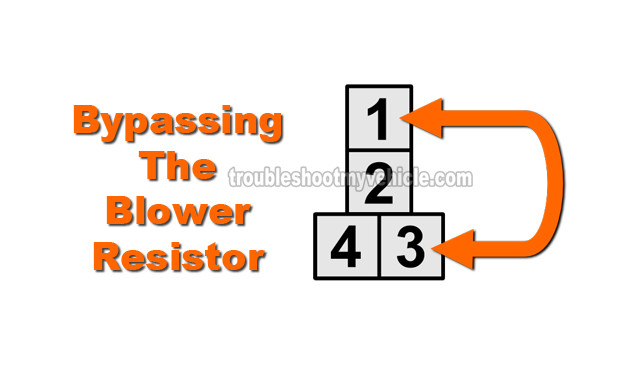TEST 2: Using A Jumper Wire To Bypass The Blower Resistor
Bypassing the blower motor resistor is a pretty easy thing to do and comes in handy to indirectly check the blower motor resistor and to make sure that the circuits between it and the blower switch are OK.
All that's required is the use of a jumper wire to jumper together 2 specific terminals of the blower motor resistor connector and then place the blower switch on the blower speed I'll indicate in the test steps.
As you bypass each blower speed, the blower motor should run if everything is OK.
IMPORTANT: Use a small diameter wire as a jumper wire or you run the risk of damaging the blower motor resistor connector's female metal terminals. If you use a too thick jumper wire, you may permanently open these terminals up and create an intermittent open-circuit problem.
Alright, these are the test steps:
- 1
Disconnect the blower motor resistor from its harness connector and turn the key to the on position (but no need to start the engine).
NOTE: All of the tests in this section are done on the blower motor resistor's harness connector and not on the resistor itself. The illustrations in the image viewer show the front view of the female metal terminals of the blower resistor connector. - 2
Jumper terminals 2 and 3 together and turn the vent position knob to VENT. This is the circuit that controls blower speed LO (see image 2 of 5).
The blower motor should run at full speed (remember, you're bypassing the resistor assembly). - 3
Jumper terminals 1 and 3 together and turn the blower switch to the M1 position (the vent position knob must be in the VENT position). Terminals 1 and 3 complete the circuit that controls blower speed M1 (see image 3 of 5).
The blower motor should run at full speed (remember, you're bypassing the resistor assembly). - 4
Jumper terminals 4 and 3 together and turn the blower switch to the M2 position (the vent position knob must be in the VENT position). Terminals 4 and 3 complete the circuit that controls blower speed M2 (see image 4 of 5).
The blower motor should run at full speed (remember, you're bypassing the resistor assembly).
Let's take a look at what your test results mean:
CASE 1: The blower motor DID NOT run when two or all of the indicated terminals were jumpered. This tells you that that specific circuit is bad or that the blower switch is bad.
You need to do two specific things to find out what's going on. The first is to test the blower switch itself by doing a continuity test of the different blower speeds. The following tutorial will help you accomplish this:
If the blower switch is OK, then there's a good chance that circuit #4 (BLK wire) does not have a good Ground. This circuit (wire) connects directly to chassis Ground is probably not making a good contact due to corrosion.
CASE 2: The blower motor ran when all of the indicated terminals were jumpered together. This tells you several important things:
- That the circuits between the resistor connector, the blower motor switch and the blower motor are OK.
- That the blower motor is OK.
No further testing is required of the blower resistor, the blower switch or the blower motor.
Where To Buy The Blower Resistor And Save
The blower resistor isn't an expensive part, especially if you shop for and buy it online.
The following links will help you comparison shop for the blower motor resistor and the resistor connector:
Disclosure: As an Amazon Associate, I earn from qualifying purchases. If my tutorials help you, using these links is an easy way to support the site at no extra cost to you. Thank you!
More Ford 4.9L, 5.0L, 5.8L Tutorials
You can find a complete list of tutorials for 4.9L, 5.0L or 5.8L equipped Fords here: Ford 4.9L, 5.0L, 5.9L Index Of Articles.
Here's a small sample of the tutorials you'll find:
- Manifold Absolute Pressure MAP Sensor Test (Ford 4.9L, 5.0L, 5.8L).
- Ignition Coil Test -No Spark No Start Tests (Ford 4.9L, 5.0L, 5.8L).
- How To Troubleshoot A No Start (Ford 4.9L, 5.0L, 5.8L).
- Testing A Blown Head Gasket (Ford 4.9L, 5.0L, 5.8L).
- How To Test Engine Compression (4.9L, 5.0L, 5.8L).
- How To Test The Ford Mass Air Flow (MAF) Sensor (at: easyautodiagnostics.com).

If this info saved the day, buy me a beer!










